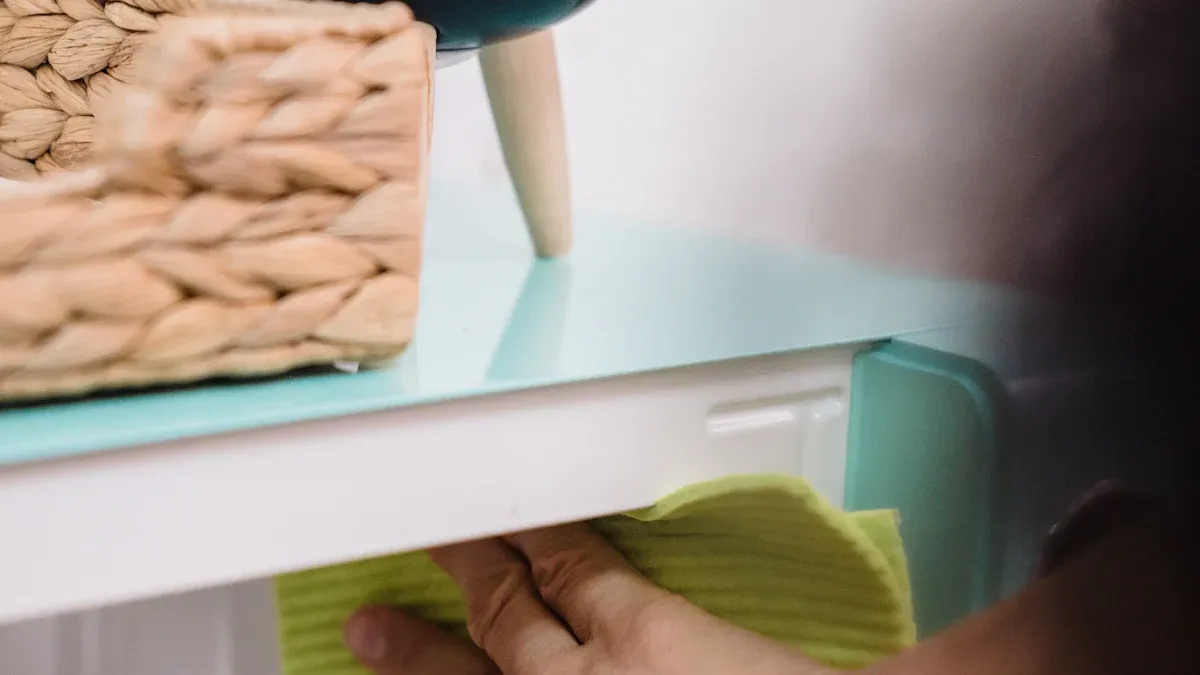
A defrosting heating element plays a vital role in keeping a refrigerator’s evaporator free from frost, ensuring efficient cooling. Over time, this component may fail due to wear, electrical issues, or prolonged use. Signs like excessive frost buildup, inconsistent cooling, or frequent defrost cycles often indicate a malfunction. Studies show that defrosting at optimal intervals, rather than fixed schedules, can reduce energy consumption by up to 25% and extend the time between defrost cycles from every 8 hours to once every 2.5 days.
Key Takeaways
- The defrost heater stops frost from forming in fridges. Keeping it in good shape helps the fridge cool better and saves energy.
- Stay safe by unplugging the fridge, clearing it out, and using safety gear before replacing the part.
- Use a simple guide to replace the heater correctly. This will make the fridge work well and last longer.
Tools, Materials, and Safety Precautions

Essential tools and materials for the job
Replacing a defrosting heating element requires the right tools and materials to ensure a smooth and efficient process. Here is a list of essential items:
- Screwdrivers: A Phillips and flathead screwdriver are necessary for removing screws and accessing internal components.
- Multimeter: This tool helps test the electrical continuity of the defrosting heating element.
- Needle-nose pliers: These are useful for gripping and removing small connectors or wires.
- Replacement defrosting heating element: Ensure the new element matches the specifications of the refrigerator model.
- Heat-resistant gloves: These protect hands from sharp edges and electrical components.
- Towel or cloth: Use this to catch any water or frost that may melt during the process.
Having these tools and materials ready before starting the replacement ensures efficiency and minimizes interruptions.
Safety precautions: Disconnecting power and preparing your workspace
Safety is paramount when working with electrical appliances. Before beginning the replacement, follow these precautions:
- Disconnect the power supply: Unplug the refrigerator from the wall outlet. If the appliance is hardwired, turn off the circuit breaker supplying power to it.
- Empty the refrigerator or freezer: Remove all food items to prevent spoilage and create a clear workspace.
- Allow the appliance to defrost: If frost has accumulated, let it melt completely. This prevents water from interfering with electrical components.
- Wear protective gear: Use heat-resistant gloves to avoid injuries from sharp edges or electrical parts.
- Organize your tools: Arrange all tools and materials within easy reach to avoid unnecessary movement during the process.
Tip: Always work in a well-lit area to ensure visibility and reduce the risk of errors.
By following these precautions, the replacement process becomes safer and more manageable.
Step-by-Step Guide to Replacing the Defrosting Heating Element

Accessing the defrosting heating element
To access the defrosting heating element, follow these steps:
- Disconnect the refrigerator from the power source by unplugging it or switching off the circuit breaker.
- Remove all food items from the freezer compartment to create a clear workspace.
- Locate the back panel inside the freezer. This panel typically covers the evaporator and the defrosting heating element.
- Use a screwdriver to remove the screws securing the panel. Keep the screws in a safe place for reassembly.
- Gently pull the panel towards you to unclip it from the chassis. Be cautious to avoid damaging any internal components.
Tip: If frost obstructs the panel, allow it to melt completely before proceeding. This prevents accidental damage to the panel or surrounding parts.
Removing the old defrosting heating element
Once the defrosting heating element is accessible, proceed with its removal:
- Identify the defrosting heating element, which is usually located beneath the evaporator coils.
- Disconnect the wires attached to the element using needle-nose pliers. Avoid pulling on the wires directly to prevent damage.
- Remove any screws or clips securing the heating element in place.
- Carefully slide the defrosting heating element out from under the evaporator.
Note: Take a moment to inspect the surrounding components for signs of wear or damage. Addressing these issues during the replacement process can save time and effort later.
Installing the new defrosting heating element
Installing the new defrosting heating element requires precision to ensure proper functionality:
- Position the new defrosting heating element in the same location as the old one, ensuring it aligns with the brackets or clips.
- Secure the element using the screws or clips removed earlier. Tighten them firmly but avoid over-tightening, which could damage the component.
- Reconnect the wires to the new heating element. Ensure the connections are secure to prevent electrical issues.
- Double-check the installation to confirm that the element is properly seated and all connections are intact.
Caution: Avoid touching the glass portion of the heating element during installation. Oils from your skin can reduce its lifespan.
Reassembling the refrigerator or freezer
After installing the new defrosting heating element, reassemble the appliance:
- Replace the back panel by aligning it with the chassis and securing it with screws.
- Ensure all screws are tightened evenly to prevent gaps that could affect airflow.
- Restore power to the refrigerator by plugging it in or turning on the circuit breaker.
- For electronic models, exit the service test mode if it was activated during the repair.
- Monitor the appliance for a few hours to confirm that the defrosting heating element is functioning correctly.
Pro Tip: Properly position all shrouds, grilles, ducts, or gaskets during reassembly. This ensures optimal airflow and cooling efficiency.
By following these steps, replacing a defrosting heating element becomes a straightforward process. Proper installation not only restores the refrigerator’s functionality but also extends its lifespan.
Troubleshooting Common Issues
What to do if the new defrosting heating element doesn’t work
If the newly installed defrosting heating element fails to operate, several factors could be responsible. Begin by verifying the electrical connections. Loose or improperly connected wires can prevent the element from functioning. Use a multimeter to test the continuity of the heating element. A lack of continuity indicates a defective component, even if it is new.
In some cases, the issue may lie with the defrost timer. A faulty timer can fail to initiate or terminate the defrost cycle correctly. Manually advance the timer and check the amperage in the defrost circuit to confirm its functionality. If the defrost cycle ends prematurely, inspect the temperature termination switch. A stuck switch can disrupt the process, requiring replacement.
Tip: Optimize defrost cycles by scheduling them based on actual frost conditions rather than fixed intervals. This approach enhances efficiency and reduces energy consumption.
Identifying other potential issues in the defrost system
When the defrosting heating element appears functional, but frost persists, other components in the defrost system may be at fault. Start by testing the continuity of the defrost heater. It should show continuity between the leads and none to the ground. Next, check the defrost termination switch. This switch should have continuity when cooled below 40°F.
If both components are operational, examine the defrost control system, which could be a timer or a control board. Replace it if necessary. Additionally, a frozen evaporator coil often points to a malfunctioning defrost timer or termination switch. Addressing these issues promptly ensures the refrigerator operates efficiently.
When to seek professional assistance
Certain situations demand professional expertise. If the outdoor coil ices over or excessive ice accumulates on the unit, the defrost cycle may not function correctly. Faulty components like temperature sensors or reversing valves often cause these issues. Professional repair services are recommended to resolve such complex problems.
Note: Attempting to repair advanced defrost system failures without proper knowledge can lead to further damage. Always consult a professional when in doubt.
Replacing a faulty defrosting heating element ensures optimal refrigerator performance. A defective heater causes frost buildup, reducing efficiency, increasing energy consumption, and risking food spoilage. Following safety precautions and the step-by-step guide minimizes errors. For complex issues, consulting a professional guarantees proper repairs and prevents further damage. Stay proactive for lasting appliance efficiency!
FAQ
What is the average lifespan of a defrosting heating element?
A defrosting heating element typically lasts 8-10 years. However, its lifespan depends on usage frequency, maintenance, and the quality of the refrigerator’s components.
Can a faulty defrosting heating element cause food spoilage?
Yes, a malfunctioning heating element leads to frost buildup, reducing cooling efficiency. This can result in uneven temperatures, potentially causing food to spoil faster than usual.
How can one ensure the replacement part matches the refrigerator model?
Check the refrigerator’s model number and specifications. Match these details with the replacement part’s label or consult the manufacturer for compatibility confirmation.
Tip: Always keep the refrigerator’s user manual handy for quick reference during repairs.
Post time: May-30-2025




